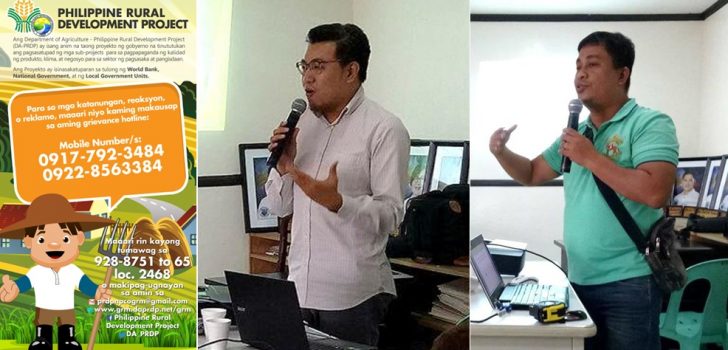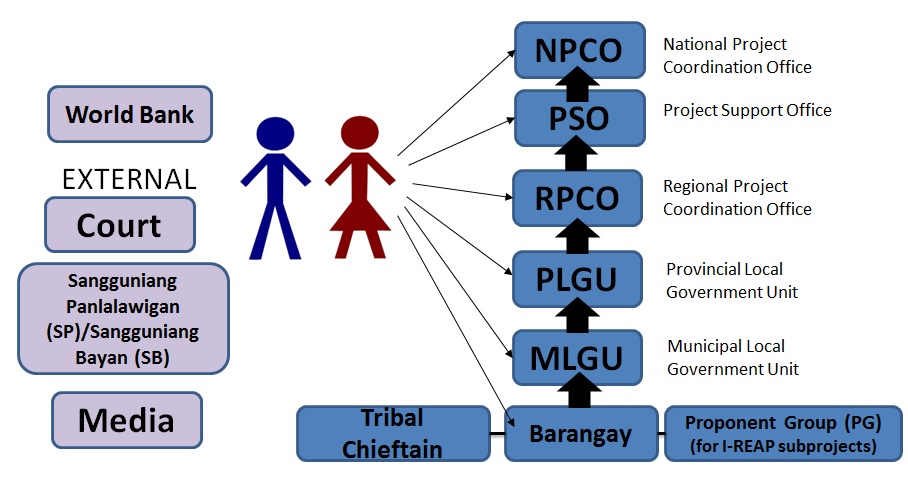
PRDP’s Grievance Redress Mechanism – the positive side of negative feedback
The Department of Agriculture’s Philippine Rural Development Project (DA-PRDP) strengthens its advocacy for community involvement through the series of trainings by the Social and Environmental Safeguards (SES) on the use of the project’s Grievance Redress Mechanism (GRM).
Led by the SES Units of the National Project Coordination Office (NPCO), Project Support Office (PSO) and Regional Project Coordination Offices (RPCO), local government unit officials and locals have continuously been equipped with knowledge on GRM and its framework, design, principles and major functions.
The grievance redress mechanism, or GRM, is an extensive subproject management system of PRDP that intends to gather concerns from Project Affected Persons (PAPs), with the intention to address and resolve these project-related complaints.
All participating local government units are required to set-up a GRM that would conform to the framework laid down for the Project.
With the simultaneous roll-out of various PRDP subprojects, one of the ideas widely promoted by the management is the active involvement of citizens with the actual implementation of projects.
“The Social and Environmental Safeguards of the PRDP is not only concerned with the Project’s current issues. We are also foreseeing what problems may emerge in the future,” said Francis Falconi, NPCO-SES Officer.
He said that a total of 60 grievance reports have so far been recorded by the national office.
“Through the GRM, not only will the general population be empowered, it will also curb possible corruption, promote transparency and improve the project process, performance and quality.”
Falconi added, “Grievances are not supposed to be taken negatively. In the long run, actions from these reported grievances will cause positive results.”
PSO Luzon A SES Unit Head Emmanuel Aragones said that while there are numerous grievances that may be reported, a significant portion of these may actually be resolved in the barangay level without the need for intervention of PRDP personnel.
“Yes, we encounter lots of citizen complaints but not all are recorded through the GRM system because it is not clear to everyone whether or not the Project must intervene.”
Regardless of this, the SES unit still encouraged the locals to submit their complaints to PRDP.
“We need GRM to address possible problems that may arise during the project construction,” said Aragones.

The GRM follows a resolution process where submitted grievances will be endorsed by the Grievance Point Person to the appropriate level/authority for proper actions and resolution. (Photo by NPCO SES)
In Central Luzon, around 20 officials from Bagac, Bataan gathered last June 5-8 to tackle GRM as an innovative tool for addressing citizen complaints.
Attended by representatives from Barangays Parang, San Antonio and Saysayin, the four-day training was aimed at capacitating barangay officials with proper knowledge in monitoring and reporting grievances that arise during the implementation of subprojects in affected areas.
A 14.8 km farm-to-market road amounting to P157.57 will soon be established in the said barangays, addressing the problems in hauling, input cost, travel time, among others.
RPCO3 I-SUPPORT Component Head Gil David said that the participation of the residents is essential for the smoother and more efficient implementation of the upcoming FMR construction in the three barangays.
“This training will help you become more vigilant in monitoring the road project,” he said. David also briefly discussed the current stage of the subproject, as well as the status of other ongoing subprojects in Central Luzon.
To encourage active participation of provinces and municipalities, 15 out of 22 provinces in North Luzon have already undergone GRM training spearheaded by the regional offices. ### (Kayla Arceo, DA-PRDP PSO InfoACE)
